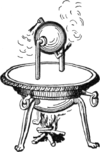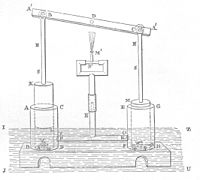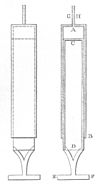- Hero of Alexandria
-
Heron 
Born c. 10 AD Residence Alexandria, Roman Egypt Fields Mathematics Known for aeolipile Hero (or Heron) of Alexandria (Greek: Ἥρων ὁ Ἀλεξανδρεύς) (c. 10–70 AD) was an ancient Greek mathematician and engineer[1][2][3] who was active in his native city of Alexandria, Roman Egypt. He is considered the greatest experimenter of antiquity[1] and his work is representative of the Hellenistic scientific tradition.[4]
Hero published a well recognized description of a steam-powered device called an aeolipile (hence sometimes called a "Hero engine"). Among his most famous inventions was a windwheel, constituting the earliest instance of wind harnessing on land.[5][6] He is said to have been a follower of the Atomists. Some of his ideas were derived from the works of Ctesibius.
Much of Hero's original writings and designs have been lost, but some of his works were preserved in Arab manuscripts.
Contents
Career
A number of references mention dates around 150 BC, but these are inconsistent with the dates of his publications and inventions. This may be due to a misinterpretation of the phrase "first century" or because Hero was a common name.
It is almost certain that Hero taught at the Musaeum which included the famous Library of Alexandria, because most of his writings appear as lecture notes for courses in mathematics, mechanics, physics and pneumatics. Although the field was not formalized until the 20th century, it is thought that the work of Hero, his "programmable" automated devices in particular, represents some of the first formal research into cybernetics.[7]
Inventions and achievements
- Hero described construction of the aeolipile (a version of which is known as Hero's engine) which was a rocket-like reaction engine and the first-recorded steam engine (although Vitruvius mentioned the aeolipile in De Architectura some 100 years earlier than Hero). It was created almost two millennia before the industrial revolution. Another engine used air from a closed chamber heated by an altar fire to displace water from a sealed vessel; the water was collected and its weight, pulling on a rope, opened temple doors.[8] Some historians have conflated the two inventions to assert that the aeolipile was capable of useful work.[9]
- The first vending machine was also one of his constructions, when a coin was introduced via a slot on the top of the machine, a set amount of holy water was dispensed. This was included in his list of inventions in his book, "Mechanics and Optics". When the coin was deposited, it fell upon a pan attached to a lever. The lever opened up a valve which let some water flow out. The pan continued to tilt with the weight of the coin until it fell off, at which point a counter-weight would snap the lever back up and turn off the valve.[10]
- A windwheel operating an organ, marking the first instance of wind powering a machine in history.[5][6]
- Hero also invented many mechanisms for the Greek theater, including an entirely mechanical play almost ten minutes in length, powered by a binary-like system of ropes, knots, and simple machines operated by a rotating cylindrical cogwheel. The sound of thunder was produced by the mechanically-timed dropping of metal balls onto a hidden drum.
- The force pump was widely used in the Roman world, and one application was in a fire-engine.
- In optics, Hero formulated the Principle of the Shortest Path of Light: If a ray of light propagates from point A to point B within the same medium, the path-length followed is the shortest possible. It was nearly 1000 years later that Alhacen expanded the principle to both reflection and refraction, and the principle was later stated in this form by Pierre de Fermat in 1662; the most modern form is that the path is at an extremum.
- A standalone fountain that operates under self-contained hydrostatic energy. (Heron's fountain)
Mathematics
Hero described a method of iteratively computing the square root.[12] Today, though, his name is most closely associated with Heron's Formula for finding the area of a triangle from its side lengths.
The imaginary number, or imaginary unit, is also noted to have been first observed by Hero while calculating the volume of a pyramidal frustum.[13]
Bibliography
The most comprehensive edition of Hero's works was published in 5 volumes in Leipzig by the publishing house Teubner in 1903.
Works known to be written by Hero:
- Pneumatica, a description of machines working on air, steam or water pressure, including the hydraulis or water organ.[14]
- Automata, a description of machines which enable wonders in temples by mechanical or pneumatical means (e.g. automatic opening or closing of temple doors, statues that pour wine, etc.). See Automaton.
- Mechanica, preserved only in Arabic, written for architects, containing means to lift heavy objects.
- Metrica, a description of how to calculate surfaces and volumes of diverse objects.
- On the Dioptra, a collection of methods to measure lengths. In this work the odometer and the dioptra, an apparatus which resembles the theodolite, are described.
- Belopoeica, a description of war machines.
- Catoptrica, about the progression of light, reflection and the use of mirrors.
Works which have sometimes been attributed to Hero, but are now thought to have most likely been written by someone else:[15]
- Geometria, a collection of equations based on the first chapter of Metrica.
- Stereometrica, examples of three dimensional calculations based on the second chapter of Metrica.
- Mensurae, tools which can be used to conduct measurements based on Stereometrica and Metrica.
- Cheiroballistra, about catapults.
- Definitiones, containing definitions of terms for geometry.
Works which are preserved only in fragments:
- Geodesia
- Geoponica
Latest paper on Hero:
- Schellenberg, H.M.: Anmerkungen zu Hero von Alexandria und seinem Werk über den Geschützbau, in: Schellenberg, H.M./ Hirschmann, V.E./ Krieckhaus, A.(edd.): A Roman Miscellany. Essays in Honour of Anthony R. Birley on his Seventieth Birthday, Gdansk 2008, 92-130 (with a huge bibliography of over 300 titles and discussion of the communis opinio on Hero).
Media
A 2007 The History Channel television show Ancient Discoveries includes recreations of most of Heron's devices.
A 2008 The History Channel television show Ancient Discoveries - "Ancient New York" includes a short recreation of a fountain device that made water flow uphill.
A 1979 Soviet animated short film focuses on Heron's invention of the aeolipile, showing him as a plain craftsman who invented the turbine accidentally.[16]
See also
- Heron's formula
- Heronian triangle
- Heronian mean
- Heron's engine
References
- ^ a b Research Machines plc. (2004). The Hutchinson dictionary of scientific biography. Abingdon, Oxon: Helicon Publishing. pp. 546. "Hero of Alexandria (lived c. AD 60) Greek mathematician and engineer, the greatest experimentalist of antiquity"
- ^ Boyer (1968 [1991]). "Greek Trigonometry and Mensuration". A History of Mathematics. pp. 171–172. "At least from the days of Alexander the Great to the close of the classical world, there undoubtedly was much intercommunication between Greece and Mesopotamia, and it seems to be clear that the Babylonian arithmetic and algebraic geometry continued to exert considerable influence in the Hellenistic world. This aspect of mathematics, for example, appears so strongly in Heron of Alexandria (fl. ca. A.D. 100) that Heron once was thought to be Egyptian or Phoenician rather than Greek. Now it is thought that Heron portrays a type of mathematics that had long been present in Greece but does not find a representative among the great figures - except perhaps as betrayed by Ptolemy in the Tetrabiblos."
- ^ Gregory A Tokaty (1994). A History and Philosophy of Fluid Mechanics. Courier Dover Publications. pp. 26. ISBN 0486681033.
Grolier Incorporated (1989). Academic American Encyclopedia. Grolier University of Michigan. pp. 144. ISBN 0717220249.
Encyclopædia Britannica Online - Heron of Alexandria
Israel Shatzman, Michael Avi-Yonah (1975). Illustrated Encyclopedia of the Classical World. Harper and Row. pp. 234. ISBN 0060101784.
Gillian Clements (2005). The Picture History of Great Inventors. frances lincoln ltd. pp. 13. ISBN 0711216053.
Enc. Britannica 2007, "Heron of Alexandria" - ^ Marie Boas, "Hero's Pneumatica: A Study of Its Transmission and Influence", Isis, Vol. 40, No. 1 (Feb., 1949), p. 38 and supra
- ^ a b A.G. Drachmann, "Heron's Windmill", Centaurus, 7 (1961), pp. 145-151
- ^ a b Dietrich Lohrmann, "Von der östlichen zur westlichen Windmühle", Archiv für Kulturgeschichte, Vol. 77, Issue 1 (1995), pp.1-30 (10f.)
- ^ Kelly, Kevin (1994). Out of control: the new biology of machines, social systems and the economic world. Boston: Addison-Wesley. ISBN 0-201-48340-8.
- ^ Hero of Alexandria; Bennet Woodcroft (trans.) (1851). "Temple Doors opened by Fire on an Altar". Pneumatics of Hero of Alexandria. London: Taylor Walton and Maberly (online edition from University of Rochester, Rochester, NY). http://www.history.rochester.edu/steam/hero/section37.html. Retrieved 2008-04-23.
- ^ for example: Mokyr, Joel (2001). Twenty-five centuries of technological change. London: Routledge. p. 11. ISBN 0-415-26931-8. "Among the devices credited to Hero are the aeolipile, a working steam engine used to open temple doors" and Wood, Chris M.; McDonald, D. Gordon (1997). "History of propulsion devices and turbo machines". Global Warming. Cambridge, England: Cambridge University Press. p. 3. ISBN 0-521-49532-6. "Two exhaust nozzles...were used to direct the steam with high velocity and rotate the sphere...By attaching ropes to the axial shaft Heron used the developed power to perform tasks such as opening temple doors"
- ^ Humphrey, John W.; John P. Oleson, Andrew N. Sherwood (1998). Greek and Roman technology: A Sourcebook. Annotated translations of Greek and Latin texts and documents. Routledge Sourcebooks for the Ancient World. London and New York: Routledge. ISBN 9-780-415-06137-7., pp.66–67
- ^ Hero of Alexandria; Bennet Woodcroft (trans.) (1851). "No. 57. Description of a Syringe.". Pneumatics of Hero of Alexandria. London: Taylor Walton and Maberly (online edition from University of Rochester, Rochester, NY). [1] Retrieved 2010 January 27
- ^ Heath, Thomas (1921). A History of Greek Mathematics, Vol. 2. Oxford: Clarendon Press. pp. 323–324. http://books.google.com/books?id=LOA5AAAAMAAJ&pg=PR323.
- ^ Nahin, Paul."An Imaginary Tale: The story of [the square root of minus one]. Princeton University Press. 1998"
- ^ Jamies W. McKinnon. "Hero of Alexandria and Hydraulis", Grove Music Online, ed. L. Macy (accessed January 17 2007), grovemusic.com (subscription access).
- ^ O'Connor, J.J. and E.F. Robertson. "Heron biography". The MacTutor History of Mathematics archive. http://www-history.mcs.st-andrews.ac.uk/history/Biographies/Heron.html. Retrieved 2006-06-18.
- ^ animator.ru
Further Reading
- Drachmann, Aage Gerhardt (1963). The Mechanical Technology of Greek and Roman Antiquity: A Study of the Literary Sources. Madison, WI: University of Wisconsin Press.
- Landels, J.G. (2000). Engineering in the ancient world (2nd ed.). Berkeley: University of California Press. ISBN 0520227824.
- Marsden, E.W. (1969). Greek and Roman Artillery: Technical Treatises. Oxford: Clarendon Press.
External links
- Webpage about Hero by The Technology Museum of Thessaloniki
- A translation of Pneumatica with diagrams
- Heron biography, The MacTutor History of Mathematics archive
- Shockwave-Applet: Herons trumpet signal
- Hero of Alexandria in the 1911 Encyclopædia Britannica
- Online Galleries, History of Science Collections, University of Oklahoma Libraries High resolution images of works by Hero of Alexandria in .jpg and .tiff format.
Greek mathematics Mathematicians Anaxagoras · Anthemius · Archytas · Aristaeus the Elder · Aristarchus · Apollonius · Archimedes · Autolycus · Bion · Boethius · Bryson · Callippus · Carpus · Chrysippus · Cleomedes · Conon · Ctesibius · Democritus · Dicaearchus · Diocles · Diophantus · Dinostratus · Dionysodorus · Domninus · Eratosthenes · Eudemus · Euclid · Eudoxus · Eutocius · Geminus · Heron · Hipparchus · Hippasus · Hippias · Hippocrates · Hypatia · Hypsicles · Isidore of Miletus · Leo the Mathematician · Marinus · Melissa · Menaechmus · Menelaus · Metrodorus · Nicomachus · Nicomedes · Nicoteles · Oenopides · Pappus · Perseus · Philolaus · Philon · Porphyry · Posidonius · Proclus · Ptolemy · Pythagoras · Serenus · Simplicius · Sosigenes · Sporus · Thales · Theaetetus · Theano · Themistoclea · Theodorus · Theodosius · Theon of Alexandria · Theon of Smyrna · Thymaridas · Xenocrates · Zeno of Elea · Zeno of Sidon · ZenodorusTreatises Centers Influences Influenced Tables Problems Categories:- 10 births
- 70 deaths
- 1st-century Greek people
- 1st-century writers
- Ancient Greek inventors
- Ancient Greek mathematicians
- Roman-era Alexandrians
- Geometers
- Ancient Greek engineers
- Ancient Egyptian engineers
- Hellenistic Egyptians
- Hellenistic engineers
- Inventors
Wikimedia Foundation. 2010.




